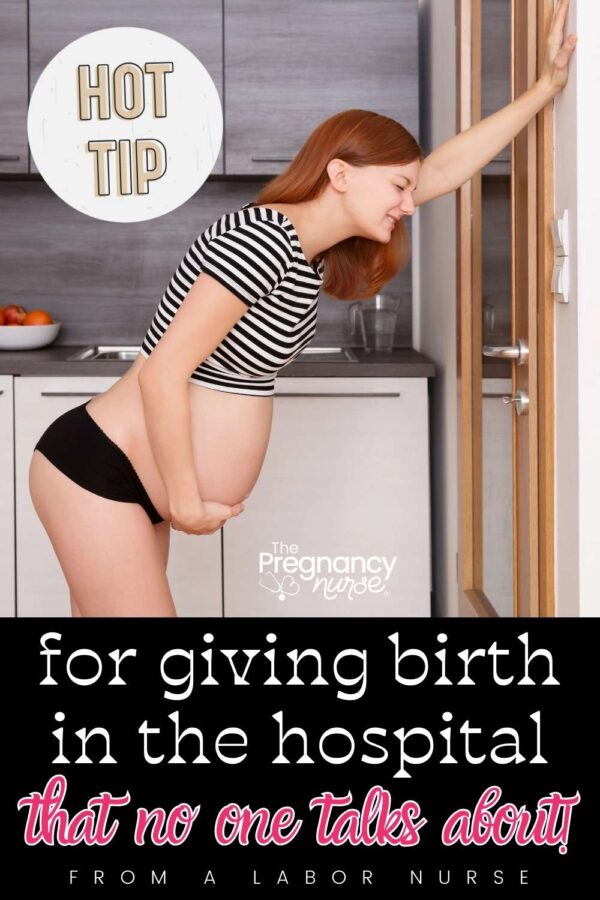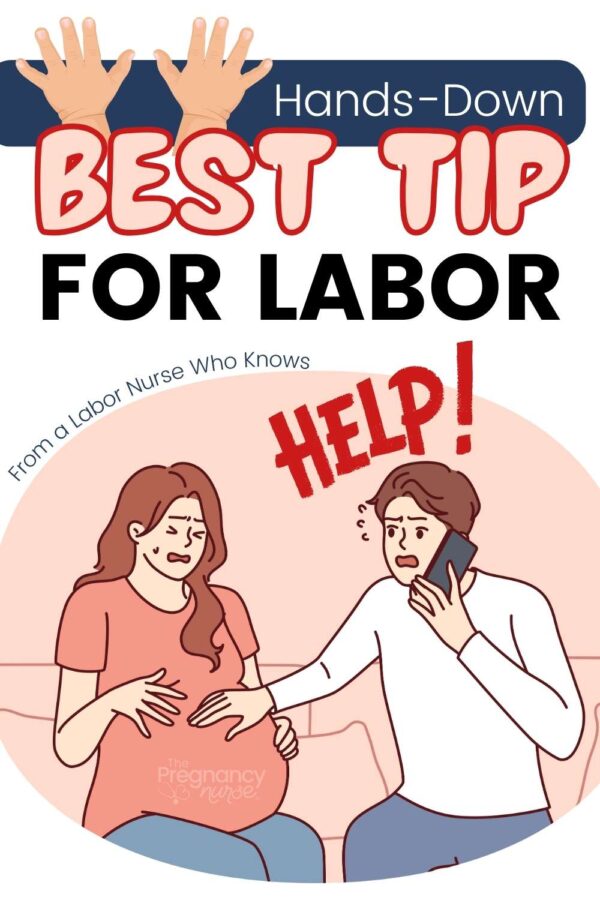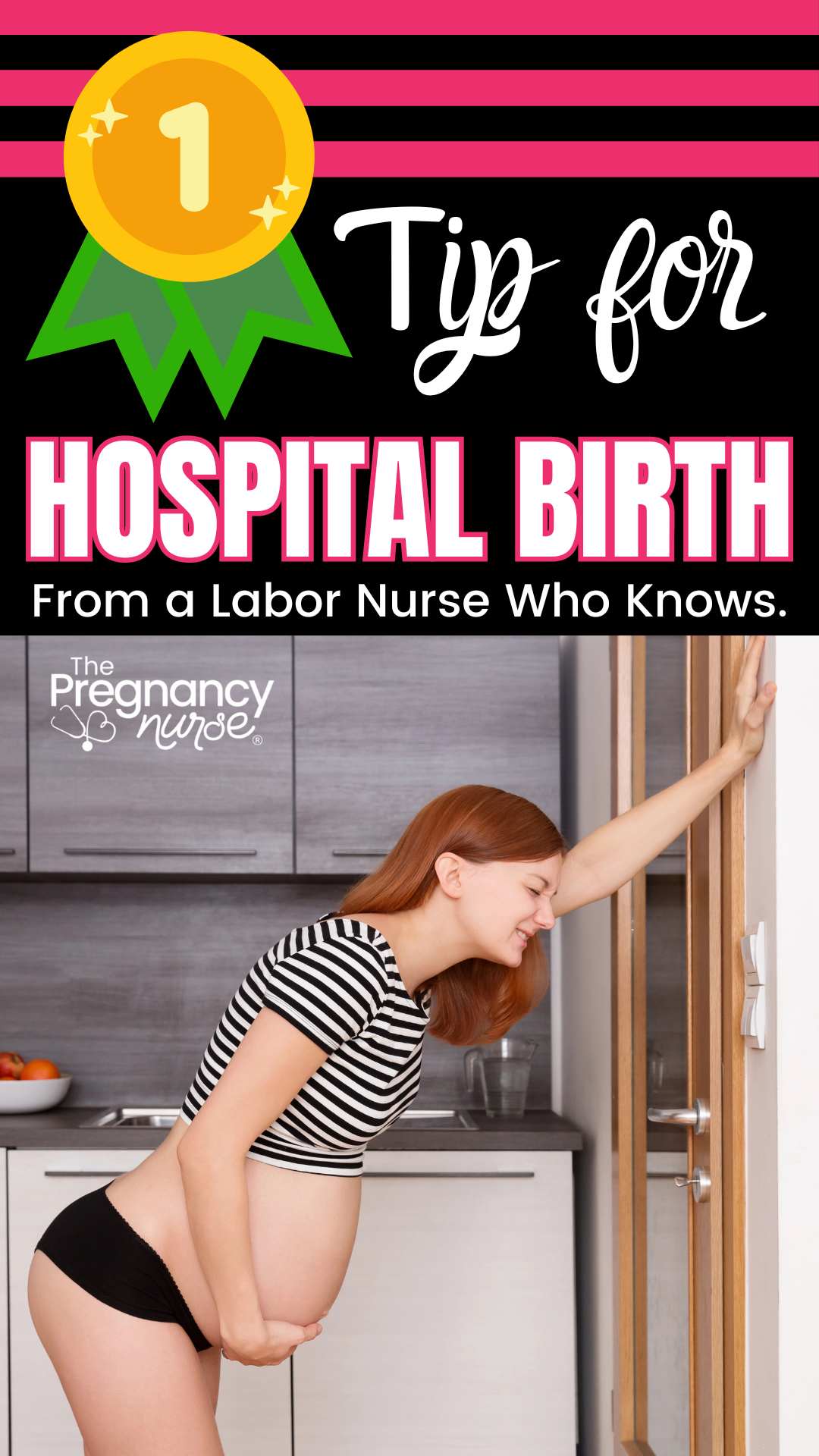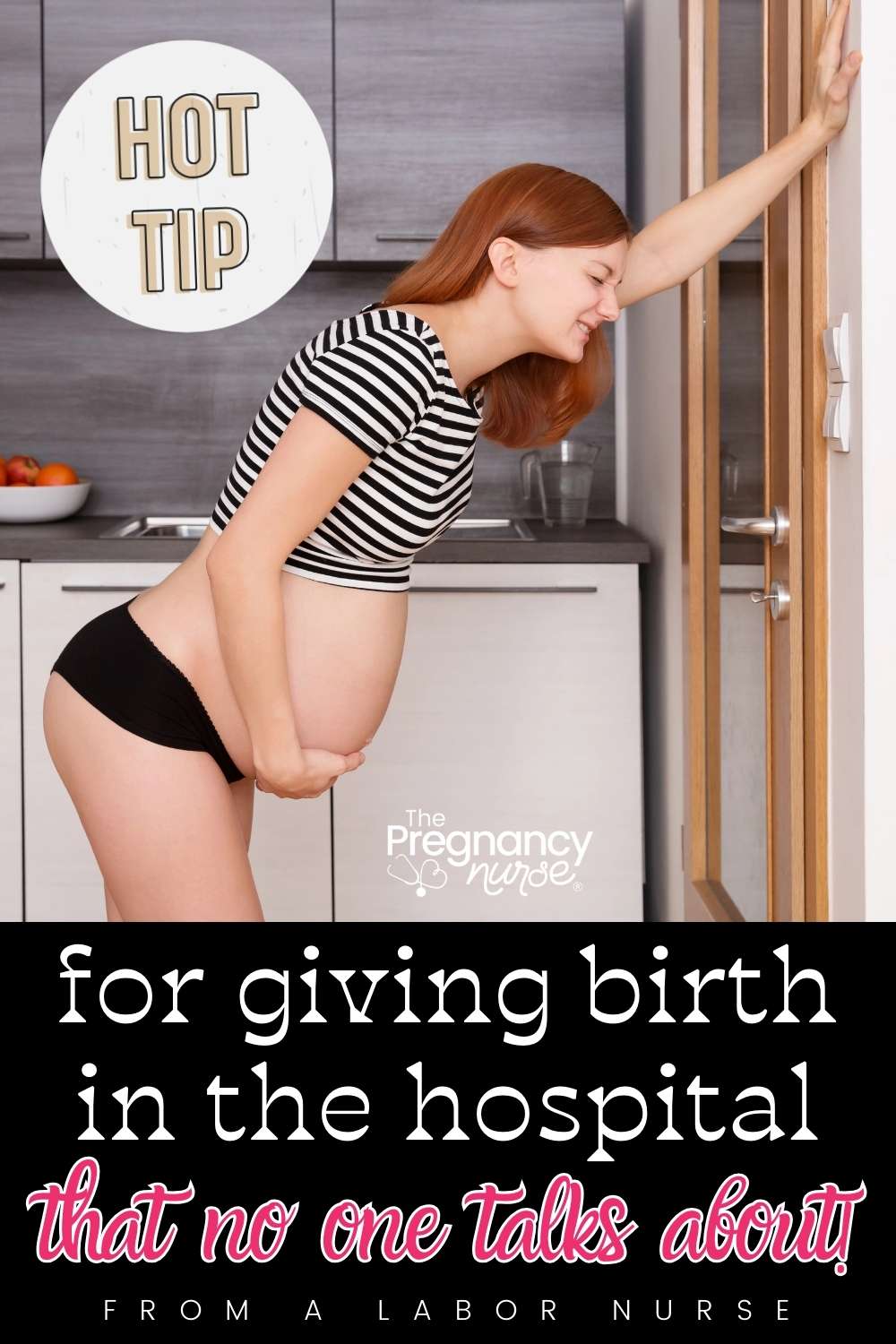There’s something that people don’t talk about, because it seems a little scary — but it truly is your BEST tip towards making for a great hospital birth (if you plan to deliver vaginally — this doesn’t work well for a planned cesarean birth). I’m even going to tell you HOW to do it — so be sure to read the whole thing.
While we’re here, another GREAT tip is to create a birth plan (or, as I like to call it a birth preference sheet). If you’re wondering the BEST way to make it — grab my best tips here:
This (or any article on The Pregnancy Nurse) should be taken as medical advice, this purely educational. Please talk with your provider about your specific needs and circumstances.

Best Tip for Vaginal Hospital Birth
Not to come too early.
Which sort of seems crazy. I mean, you’re paying the hospital to help you have your baby — why not go early. I’m definitely a rope-dropper at Disneyland, because I want to get my dollar’s worth, right?
And I get that. I also get that the media acts like after your first contraction you’re going to want to head to the hospital.
But, I’m going to tell you a little secret right now:
The hospital is the best place for you (and I truly believe that) when you’re in active labor. It, for the most part, is not a great place for you when you’re in early labor.
If you want the definitions as to when that is:
- Early labor lasts from when you’re contracting until your cervix is 4-6 cm.
- ACTIVE labor starts at 4-6 cm — Mostly we count it as when you’re “actively” dilating (meaning if we check your cervix now and then check it an hour later it’s measurably changed).
If you’re thinking — huh, there’s stages to this thing, YES — I have a stages of labor video bundled in here. It explains all of it (and my best tip as to why knowing them is important).
Looking to get prepare for your birth? I have some easy options for you!
~~~~~~~~
– Worried you’re missing something? Grab my pregnancy planner so you don’t miss a thing!
– Thinking about an induction? Grab Inductions Made Easy to feel prepared in just 20 minutes!
– Wondering how to get that baby OUT? Grab Going Into Labor Made Easy so you know how to (and not to) do it!
– Postpartum got you anxious? Check out Postpartum Care Made Easy so you can stay SAFE even when all your attention is on that little on.
🚨 AND if ALL OF IT has got you on edge The Online Prenatal Class for Couples is perfect for you — You’ll feel so ready before you even know it!
~~~~~~~~
No matter WHERE you are at in your pregnancy journey, we have resources that can help!
Why not go to the hospital in early labor?
Beyond early labor can last a REALLY long time (honestly, surprisingly long for most people)… there are a few reasons:
Early labor may peter-out: Meaning we could admit you, throw in your IV and all that jazz only to realize that labor has stopped. If augmenting your labor isn’t an option you may be best served by going home at that point, and we try to not do that (if possible — it does happen though).
We monitor: Labor & delivery is one of the most litigious places in the hospital — which means we have to keep eagle eyes on you and your baby when you’re in our care. In my post on intermittent monitoring I reveal that our continuous monitoring may not actually be safer (or worse) — especially during early labor. It, however, is the standard of care in the US from minute 1 in labor and delivery.
Because we monitor you, it can mean that movement is limited when you’re at the hospital (although, probably less than you think — and we talk about options in here). Making sure you’re moving, eating, and feeling relaxed are KEYS to early labor and the hospital doesn’t really promote any of those.
A Watched Pot: Ultimately, it boils down to this. We’re watching you, and sometimes a watched pot never boils. Or, we try things to make the pot boil that aren’t helpful. Or, we think there’s a problem and we intervene when it wasn’t really necessary.
If you’re thinking to yourself — I thought the hospital was the safest place to be in labor? << I get that.
I understand that thought — but I think understanding how to best use the hospital is actually my BEST tip for ALL types of labor.
In order to do that, you need to learn from someone who really understands the hospital and how it is best used — which is why I created one of the first online birth classes. After LOTS of updates – The Online Prenatal Class for Couples is for people who:
- Want to find a birth class that fits them (rather than adjusting to fit a class)
- Want to get prepared for whatever type of birth they have because they know you don’t always get to choose.
- Want to learn from an expert who’s also fun and engaging.
In just a few hours we can get you feeling prepared.
We actually have a whole chapter on early labor, what it looks like, what you can do and when you should start to consider the hospital.
Things to promote in early labor:
In early labor you want to promote:
- Rest (when you’re sleeping, SLEEP)
- Movement (when you’re not sleeping, move, and at least change position frequently if you’re not up for walking / lunging / labor balling)
- Eat — your body needs calories to keep this marathon up! This can also help with…
- Relax — the more comfortable you can be, the better. When you get tense it can throw-off the oxytocin system.
And frankly, as someone who’s spent countless hours in labor and delivery after working there for 20 years, the hospital mostly fails at every single one of these.

What to do when you’re in early labor?
Ok, so if you’re not supposed to grab that hospital bag and run for the hospital — what SHOULD you do?
Well, do the things I talked about above:
Sleep
If you really can sleep do it! Now, if you’re just “resting your eyes” you want to move to the next step — but I’m a HUGE fan of sleeping in early labor.
- It gives your body the rest it desperately needs to do this marathon of labor/birth
- It lets your body relax, and hopefully baby moves into a great spot!
Want to know more about sleep during pregnancy — check out these posts:
- Can Labor Start While Sleeping?
- Can You Sleep Through Contractions – Especially Early Labor?
- Sleeping Positions To Induce Labor: Best Positions To Dilate
- Unisom For Sleep During Pregnancy
- Pillows For Pregnant Stomach Sleepers
Move
Ok, when you’re not sleeping move.
Now, if you’re just dog tired that can be shifting your hips every 20-30 minutes (this is a GREAT job for your partner to help you move and keep track of time and make sure you’re moving when not asleep).
But I’m also a fan of other movements:
- Cleaning — not only are these great movements to get baby into your pelvis, but you’ll appreciate having that stuff done — and yes, I 100% recommend having your partner do it with you. This is a team sport.
- Cooking — it’s a great way to get your mind off labor pains, it’s awesome to sway and bend and just enjoy the act of cooking. And yes, I recommend having your partner do anything you’re not up for (cutting up stuff always hurt my back when I was pregnant due to my belly hitting the counter). Great time to get some freezer meals made for after baby too!
- Walking — going on a walk can get some fresh air in you, some vitamin D if it’s day time and can help you feel invigorated and possibly tired enough for a walk. Don’t forget a bit of curb walking too!
- Labor ball time — sexy hip circles on the labor ball can be nice when you’re tired but not enough to sleep. Find a show you love!
Some people might feel up for a workout or some squats, etc. Whatever you’re up to and feels good I think is great!
I have some labor movement cards that gives you loves of ideas how to move in labor right here.

Eat
In the hospital, we somehow stop people from eating, and that’s a whole other bag of chips beyond this post — but you should be eating at home!
I recommend eating things that include carbs and proteins. Now is not a great time for you to dump after a sugar high. We talk about some great things to eat in labor in the nutrition bonus video in here.
Relax
Whatever you can do to relax is going to help.
One of the biggest problems with labor is that you’re in pain, which often makes your whole body tense up.
BUT, at the same time you need to relax to let baby enter your pelvis.
Breathing exercises like I teach in the natural pain management video in here totally help you relax that pelvis.
Some people find getting closeness with your partner (no matter how that looks) can be a win too. Something to consider. 🙂
Having a partner who’s supporting you in this and not freaking out is one of the KEYS to making this work. That’s why taking a class together is so smart — you can BOTH make this a priority!

What to do when you think you’re in labor?
I always think it’s a good thing to call your provider. They can go through with you what to watch for, and when you either call them back or head into the hospital.
Good providers have someone on for them 24/7.
There are problem signs that may need point you to leaving earlier (decreased fetal movement, bleeding, etc) — that are best reviewed with your provider.
There are also some complications of your pregnancy that may make you want to head into the hospital earlier — things like placental issues, a positive GBS test, hypertension, or other complications. So, you’ll want to make sure your doctor is good with you hanging out at home for a while.
It’s a great question to ask them at your prenatal appointments — and how to tailor this information to you and YOUR needs.
You may be realizing that prenatal appointments just aren’t enough time to learn all the things you need to for pregnancy, labor, birth & life after baby. I really recommend a class that covers the basics so you can learn more about YOU and YOUR needs at your prenatal appointments.
This one does just that (did I mention it only takes 3 hours!).

WHEN to go to the hospital?
This is a great question, and it really varies. It’s one of those questions you need to ask your provider at appointments.
I do have a whole post on when to go to the hospital, and the many factors that go into that choice.
I am hearing SO much anymore that people have an hour+ hospital drive, which really does change things. I’m hearing a lot of people staying at a hotel or close to the hospital if that’s the case and I think it’s a great idea if that’s an option (and I’m aware that it’s not for everyone).
The good news, there are some tell-tale signs that say you’re heading into active labor and it’s time to head on in. I go over all of those in here so that you’re prepared for what’s to come!
Either way, I LOVE that you’re learning about what to do when you’re in labor and how to best act when that happens. I’d love to have you in my class to learn more.
Want to do a vibe check before diving into the whole thing with me? — check out my free labor pro tips. It’s your first step toward getting in the driver’s seat of your birth.












 What Does the Mucus Plug Look Like?
What Does the Mucus Plug Look Like?
